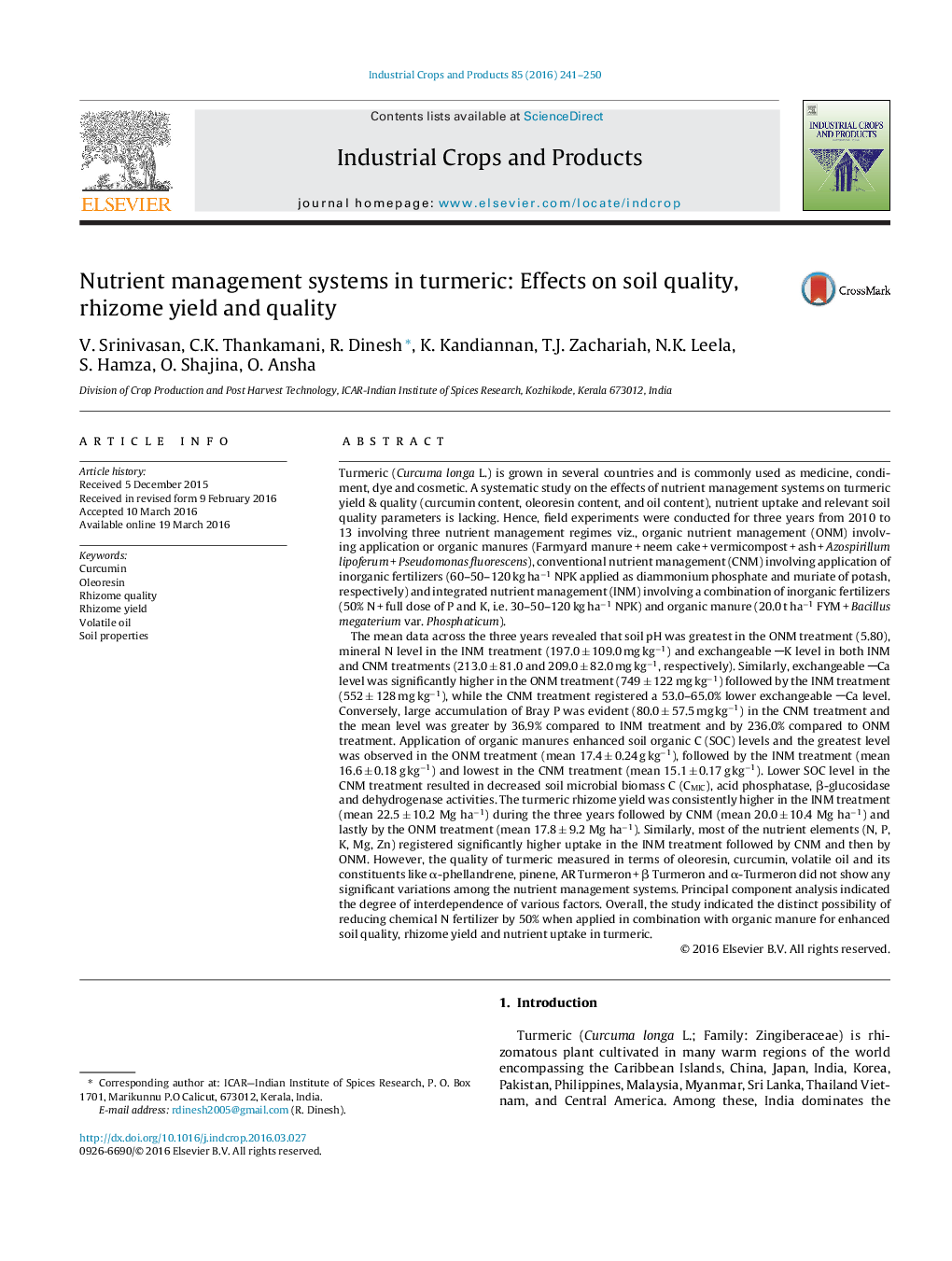| کد مقاله | کد نشریه | سال انتشار | مقاله انگلیسی | نسخه تمام متن |
|---|---|---|---|---|
| 4512478 | 1624825 | 2016 | 10 صفحه PDF | دانلود رایگان |
• Organic and integrated treatments had higher pH, SOC, Ca & microbial activity.
• Conventional treatment had lower pH, SOC, mineral N, K, biomass C & high P.
• Rhizome yield was in the order of INM > CNM> ONM.
• Oleoresin, curcumin and volatile oil did not vary among the treatments.
• Uptake of N, P, K, Mg and Zn was higher in integrated treatment.
Turmeric (Curcuma longa L.) is grown in several countries and is commonly used as medicine, condiment, dye and cosmetic. A systematic study on the effects of nutrient management systems on turmeric yield & quality (curcumin content, oleoresin content, and oil content), nutrient uptake and relevant soil quality parameters is lacking. Hence, field experiments were conducted for three years from 2010 to 13 involving three nutrient management regimes viz., organic nutrient management (ONM) involving application or organic manures (Farmyard manure + neem cake + vermicompost + ash + Azospirillum lipoferum + Pseudomonas fluorescens), conventional nutrient management (CNM) involving application of inorganic fertilizers (60–50–120 kg ha−1 NPK applied as diammonium phosphate and muriate of potash, respectively) and integrated nutrient management (INM) involving a combination of inorganic fertilizers (50% N + full dose of P and K, i.e. 30–50–120 kg ha−1 NPK) and organic manure (20.0 t ha−1 FYM + Bacillus megaterium var. Phosphaticum).The mean data across the three years revealed that soil pH was greatest in the ONM treatment (5.80), mineral N level in the INM treatment (197.0 ± 109.0 mg kg−1) and exchangeable K level in both INM and CNM treatments (213.0 ± 81.0 and 209.0 ± 82.0 mg kg−1, respectively). Similarly, exchangeable Ca level was significantly higher in the ONM treatment (749 ± 122 mg kg−1) followed by the INM treatment (552 ± 128 mg kg−1), while the CNM treatment registered a 53.0–65.0% lower exchangeable Ca level. Conversely, large accumulation of Bray P was evident (80.0 ± 57.5 mg kg−1) in the CNM treatment and the mean level was greater by 36.9% compared to INM treatment and by 236.0% compared to ONM treatment. Application of organic manures enhanced soil organic C (SOC) levels and the greatest level was observed in the ONM treatment (mean 17.4 ± 0.24 g kg−1), followed by the INM treatment (mean 16.6 ± 0.18 g kg−1) and lowest in the CNM treatment (mean 15.1 ± 0.17 g kg−1). Lower SOC level in the CNM treatment resulted in decreased soil microbial biomass C (CMIC), acid phosphatase, β-glucosidase and dehydrogenase activities. The turmeric rhizome yield was consistently higher in the INM treatment (mean 22.5 ± 10.2 Mg ha−1) during the three years followed by CNM (mean 20.0 ± 10.4 Mg ha−1) and lastly by the ONM treatment (mean 17.8 ± 9.2 Mg ha−1). Similarly, most of the nutrient elements (N, P, K, Mg, Zn) registered significantly higher uptake in the INM treatment followed by CNM and then by ONM. However, the quality of turmeric measured in terms of oleoresin, curcumin, volatile oil and its constituents like α-phellandrene, pinene, AR Turmeron + β Turmeron and α-Turmeron did not show any significant variations among the nutrient management systems. Principal component analysis indicated the degree of interdependence of various factors. Overall, the study indicated the distinct possibility of reducing chemical N fertilizer by 50% when applied in combination with organic manure for enhanced soil quality, rhizome yield and nutrient uptake in turmeric.
Figure optionsDownload as PowerPoint slide
Journal: Industrial Crops and Products - Volume 85, July 2016, Pages 241–250
